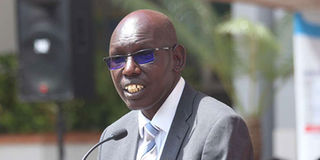Ministry issues strict rules on Form One choices

Education Principal Secretary Belio Kipsang. PHOTO | FILE | NATION MEDIA GROUP
What you need to know:
- National schools are centres of excellence established to stimulate education standards and foster national unity and social cohesion. Their catchment is 100 per cent national.
Extra-county schools are boarding schools that are second tier national centres of education excellence.
County schools are boarding secondary schools in counties other than national and extra-county schools. They include day schools in cities and major urban centres. Their catchment is the host count.
Sub-county schools are day schools, all new boarding schools and boarding schools with day wings. They draw their students solely from the host sub-county.
The Ministry of Education has issued guidelines on how 1,088,986 candidates will revise their secondary schools preferences in an exercise set to be concluded by August 2.
In the circular to regional directors of education by the Education Principal Secretary Belio Kipsang, candidates will be permitted to select 11 schools at different categories. The circular, dated June 24, is signed by Mr Paul Kibet.
COMPETITIVE
According to the Ministry of Education, the introduction of second selection is to make the process more effective and efficient.
“Over time, the Ministry has realised that some candidates wish to revise their Form One selection choices in Term Two after having effectively assessed their likely Kenya Certificate of Primary Education Examinations (KCPE) potential based on class assessments,” said Education Cabinet Secretary Prof George Magoha.
In the circular, Dr Kipsang said candidates will be placed in the schools based on merit, students’ choice and equity and affirmative action.
National schools have been put in four clusters and candidates will choose one school per cluster. Students have been advised to choose the most competitive school as number one.
However, Dr Kipsang said admission to Starehe Boys Centre and Starehe Girls are pre-selections.
“Unless a student is from a needy background, they may not get placement in the school. Besides that, the student must have chosen the school as their first choice and filled in a ‘yellow form’ from the school by July 31.
At Moi forces Academy, pre-selection is 80 percent as well as at Utumishi Academy.
The Ministry of Education is also concerned with the trend where wrong gender code is entered, which leads to students being selected to a school of a wrong gender.
Dr Kipsang asked candidates to pay attention to the clustering of extra-county schools into three clusters, saying that some county schools have been upgraded to extra-county schools and sub-county ones upgraded to county schools.
SPECIAL SCHOOLS
However, he said national schools would remain as they were.
“Care should be taken to avoid candidates choosing special schools yet they have no disability,” said Dr Kipsang.
The move by the Ministry of Education is also expected to ease pressure on elite schools as candidates will have gauged their capacities.
For instance last year, more than a million KCPE candidates scrambled for slots in 15 national schools, ruining their chances of joining their preferred institutions.
The report by the Ministry of Education revealed that out of the total 1,052,364 candidates who sat the examination in November, some 1,008,028 chose the 15 schools as their first choice, leaving only 44,336 candidates to fight for slots in the remaining 88 national schools.
The schools that attracted a majority of the candidates include Alliance High, Mang’u, Lenana, Nairobi, Starehe Boys, Maseno, Kapsabet Boys and Maranda High among others.
This year’s candidates will sit their examinations in 27,809 centres while a total of 2,423 candidates with special needs have been registered and Knec will conduct their assessment between July 1 and 26 to determine the nature of assistance to be given during the examination.
Knec acting chief executive officer Dr Mercy Karogo disclosed that 20 additional containers have been purchased to increase the number of containers to 479 that will be used for the storage and distribution KCPE examination papers.
PRESTIGIOUS
“A total of 173,945 personnel will be used during the field administration of the examination,” said Dr Karogo.
In 2015, the government developed tough guidelines on Form One selection. Under the new rules, the 103 national schools were grouped into four clusters, with each candidate required to pick only one school from each cluster.
The 18 schools considered more prestigious than the recently gazetted ones were all put in the third cluster, meaning no candidate can select any two of them.
A recent report by Auditor General Edward Ouko revealed that 85 national schools that were upgraded were not attracting students.
“The continued pressure on the original national schools was attributed to low reporting rate in the upgraded schools. An analysis shows that 13 out of 16 newly upgraded schools could not attract even a half of the students selected and in some cases only 3 percent reported,” reads the report.
National schools are centres of excellence established to stimulate education standards and foster national unity and social cohesion. They are boarding schools whose catchment is 100 percent national.
CATCHMENT
Extra-county schools are boarding schools that are second tier national centres of education excellence.
County schools are boarding secondary schools in counties other than national and extra-county schools. They include day schools in cities and major urban centres. Their catchment is the host count.
Sub-county schools are basically day schools, all new boarding schools and boarding schools with day wings. They draw their students solely from the host sub-county.
Selection of candidates to extra-county schools is based on the ratio of 20:40:40, where, 20 percent is reserved for the host sub-county, 40 percent for host county and 40 percent for other counties other than the host county
In addition to its 20 percent allocation, the host sub-county shares in the county’s share of 40 percent. Sub-county quota in the host county in an extra-county school is based on its candidature strength using the following formula: available places in county schools are shared out between sub-counties in the ratio of 20:80 – 20 percent of places reserved for the host sub-county and 80 per cent for the host county and shared out equitably among all the sub-counties therein, the host sub-county inclusive





